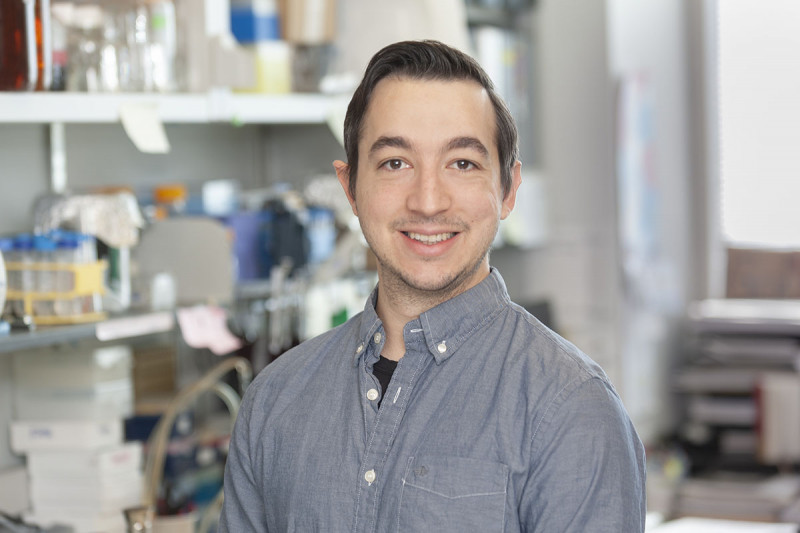
Mehmet Erman Karasu, a recent graduate of Gerstner Sloan Kettering, is the 2019 Chairman's Prize winner.
Mehmet Erman Karasu, a recent graduate of the Gerstner Sloan Kettering Graduate School of Biomedical Sciences (GSK), has been awarded the 2019 Chairman’s Prize. The competitive award is presented annually and was established by GSK’s Board of Trustees Chair Louis V. Gerstner, Jr., for whom the school is named.
This year’s Chairman’s Prize, in the amount of $2,000, recognizes Dr. Karasu’s research, which sheds light on meiosis, the complex cell-division process that gives rise to reproductive cells, such as eggs and sperm.
Below, Dr. Karasu describes his winning thesis work, which he conducted in the laboratory of Memorial Sloan Kettering molecular biologist Scott Keeney. The lab studies the mechanisms by which cells make and repair breaks in their DNA during meiosis.
Dr. Karasu is now pursuing postdoctoral research at ETH Zurich.
My work highlights the roles of two germ-cell-specific genes in mammalian meiosis.
The first paper, “Cyclin B3 promotes anaphase I onset in oocyte meiosis,” was published in the Journal of Cell Biology. This paper aimed to uncover if and how an enigmatic protein called cyclin B3 contributes to female meiosis, spermatogenesis, and oogenesis.
By employing CRISPR-Cas9, a gene-editing tool, we generated a knockout allele of the cyclin B3 gene in mice. Our research showed that male mice lacking cyclin B3 were completely normal and did not need cyclin B3 to complete meiotic divisions and produce sperm cells. This was surprising because, in mammals, cyclin B3 is expressed in germ cells but not in somatic cells. In contrast, female mice lacking cyclin B3 are completely sterile.
In collaboration with Nora Bouftas and Katja Wassmann of the Institut de Biologie Paris-Seine, we found that cyclin B3 is required for oocytes to complete their first meiotic division. Interestingly, meiotic division was restored when we introduced cyclin B3 from other organisms, such as frogs or zebrafish, back into cyclin B3 knockout oocytes, indicating an evolutionarily conserved role for this cyclin.
Our experiments further showed that cyclin B3 regulates the activity of the anaphase-promoting complex (APC/C) enzyme during the cell’s transition from metaphase (the second stage of cell division, during which chromosomes line up in preparation for separation) to anaphase (a later stage of cell division, during which chromosomes move to the poles of the spindle). While APC/C activity is required for cell division, its regulation in different cell types is not fully understood. Our results indicate that cyclin B3 plays a unique role in the regulation of the APC/C in oocytes. More research is needed to uncover the mechanism behind this process.
The second paper, “REC114 partner ANKRD31 controls number, timing, and location of meiotic DNA breaks,” was published in Molecular Cell. Here, we investigated the role of ankyrin repeat domain-containing 31 (ANKRD31), a novel meiotic protein that is required for normal fertility.
The mechanisms governing meiosis have been well-studied in budding yeast, but researchers have identified only a few of the proteins that are required for the formation of DNA double-strand breaks (DSB) during meiosis in mice. To search for unique candidates, I performed a two-hybrid screen in yeast using the mouse REC114 protein as a bait. (REC114 is essential for DSB formation in meiosis.) I discovered that REC114 directly interacts with ANKRD31, a previously uncharacterized protein.
Sloan Kettering Institute (SKI) research fellow Michiel Boekhout and I then showed that male mice devoid of the Ankrd31 gene are sterile and experience major problems during meiotic prophase (the first phase of cell division, while homologous chromosomes experience genome-wide DSBs and then pair with one another.) Our analysis demonstrated that a substantial number of spermatocytes arrested during meiotic prophase I. Strikingly, we observed that sex chromosomes were not able to pair, synapse, and recombine in spermatocytes that had mutations in Ankrd31.
In collaboration with R. Daniel Camerini-Otero’s group at the National Institutes of Health, we analyzed the DSB landscape in the Ankrd31 mutant. We did not observe any DSB signal from a small part of the sex chromosomes called the pseudoautosomal region. This region is the only segment where the X and Y chromosomes share homology, so it is the only segment where the sex chromosomes can recombine in male meiosis. Our results revealed for the first time that the ANKRD31 protein is essential for X-Y recombination.
We also collaborated with SKI research fellow Juncheng Wang and structural biologist Dinshaw Patel to solve the structure of the minimal interaction domains of ANKRD31 and REC114. This is the one of the first structures of a DSB protein interaction deciphered in the field.


